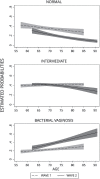Prevalence of bacterial vaginosis and Candida among postmenopausal women in the United States
- PMID: 25360022
- PMCID: PMC4303100
- DOI: 10.1093/geronb/gbu105
Prevalence of bacterial vaginosis and Candida among postmenopausal women in the United States
Abstract
Objectives: To describe the prevalence of bacterial vaginosis (BV) and Candida among community-dwelling postmenopausal women in the United States and determine their change with age, using estimates based on Waves 1 and 2 of the National Social Life, Health and Aging Project (NSHAP).
Method: Self-administered vaginal swabs were collected in-home from women aged 57-85 (n = 1,016) in Wave 1 and again 5 years later in Wave 2 (n = 883). Gram-stained specimens were evaluated for BV using the Nugent score as well as presence of Candida.
Results: BV was prevalent in 23% and 38% of postmenopausal women in Waves 1 and 2 and increased with age. Women initially categorized with BV in Wave 1 were more than 10 times as likely to be categorized with BV in Wave 2, relative risk ratio (RRR) = 10.5; 95% confidence interval (CI) (4.45-24.7); p < .001, whereas women initially categorized as intermediate in Wave 1 were five times more likely to have a BV categorization, RRR = 5.0; 95% CI (2.56-9.75); p < .001. Although the presence of Candida was similar in both waves (6% and 5%), its relationship with age only became evident in Wave 2, with odds of detecting Candida decreasing by 7% with each year of age, OR = 0.93, 95% CI (0.88, 0.98); p = .010.
Discussion: In Wave 2, the prevalence of BV was higher and increased with age while the prevalence of Candida was low and declined with age. A 5-year age increase contributed to the prevalence change across waves. Methods refinements in Wave 2 improved the detection of BV and Candida and clarified their relationship with age.
Keywords: Bacterial vaginosis; Candida; Population; Postmenopause; Self-collection; Vaginal swab..
© The Author 2014. Published by Oxford University Press on behalf of The Gerontological Society of America. All rights reserved. For permissions, please e-mail: journals.permissions@oup.com.
Figures




Similar articles
-
Evaluation of reliability of self-collected vaginal swabs over physician-collected samples for diagnosis of bacterial vaginosis, candidiasis and trichomoniasis, in a resource-limited setting: a cross-sectional study in India.BMJ Open. 2019 Aug 27;9(8):e025013. doi: 10.1136/bmjopen-2018-025013. BMJ Open. 2019. PMID: 31462459 Free PMC article.
-
Prevalence of bacterial vaginosis and associated risk factors in pregnant women receiving antenatal care at the Kumba Health District (KHD), Cameroon.BMC Pregnancy Childbirth. 2019 May 10;19(1):166. doi: 10.1186/s12884-019-2312-9. BMC Pregnancy Childbirth. 2019. PMID: 31077161 Free PMC article.
-
The relationship of bacterial vaginosis, Candida and Trichomonas infection to symptomatic vaginitis in postmenopausal women attending a vaginitis clinic.Maturitas. 1997 Jul;27(3):253-60. doi: 10.1016/s0378-5122(97)00038-8. Maturitas. 1997. PMID: 9288698
-
Prevalence, risk factors and adverse pregnancy outcomes of second trimester bacterial vaginosis among pregnant women in Bukavu, Democratic Republic of the Congo.PLoS One. 2021 Oct 25;16(10):e0257939. doi: 10.1371/journal.pone.0257939. eCollection 2021. PLoS One. 2021. PMID: 34695126 Free PMC article.
-
Prevalence of bacterial vaginosis in postmenopausal women: a systematic review and meta-analysis.Sex Health. 2022 Mar;19(1):17-26. doi: 10.1071/SH21083. Sex Health. 2022. PMID: 35192453
Cited by
-
Vaginal microbiome variances in sample groups categorized by clinical criteria of bacterial vaginosis.BMC Genomics. 2018 Dec 31;19(Suppl 10):876. doi: 10.1186/s12864-018-5284-7. BMC Genomics. 2018. PMID: 30598080 Free PMC article.
-
The Effect of Prangos Ferulacea Vaginal Cream on Accelerating the Recovery of Bacterial Vaginosis: A Randomized Controlled Clinical Trial.Int J Community Based Nurs Midwifery. 2018 Apr;6(2):100-110. Int J Community Based Nurs Midwifery. 2018. PMID: 29607339 Free PMC article.
-
Association Between Vaginal Bacterial Microbiota and Vaginal Yeast Colonization.J Infect Dis. 2021 Mar 3;223(5):914-923. doi: 10.1093/infdis/jiaa459. J Infect Dis. 2021. PMID: 32726445 Free PMC article.
-
Helicobacter is preserved in yeast vacuoles! Does Koch's postulates confirm it?World J Gastroenterol. 2017 Mar 28;23(12):2266-2268. doi: 10.3748/wjg.v23.i12.2266. World J Gastroenterol. 2017. PMID: 28405156 Free PMC article.
-
Associations of the vaginal microbiota with HIV infection, bacterial vaginosis, and demographic factors.AIDS. 2017 Apr 24;31(7):895-904. doi: 10.1097/QAD.0000000000001421. AIDS. 2017. PMID: 28121709 Free PMC article.
References
-
- Allsworth J. E., Peipert J. F. (2007). Prevalence of bacterial vaginosis: 2001-2004 National Health and Nutrition Examination Survey data. Obstetrics and Gynecology, 109, 114–120. 10.1097/01.AOG.0000247627.84791.91 - PubMed
-
- Alnaif B., Drutz H. P. (2000). Bacterial vaginosis increases in pessary users. International Urogynecology Journal and Pelvic Floor Dysfunction, 11, 219–222 Retrieved from http://www.ncbi.nlm.nih.gov/pubmed/11005473 - PubMed
-
- Amsel R., Totten P. A., Spiegel C. A., Chen K. C., Eschenbach D., Holmes K. K. (1983). Nonspecific vaginitis. Diagnostic criteria and microbial and epidemiologic associations. The American Journal of Medicine, 74, 14–22 Retrieved from http://www.ncbi.nlm.nih.gov/pubmed/6600371 - PubMed
-
- Anderson M. R., Klink K., Cohrssen A. (2004). Evaluation of vaginal complaints. JAMA: the journal of the American Medical Association, 291, 1368–1379. 10.1001/jama.291.11.1368 - PubMed
Publication types
MeSH terms
Grants and funding
LinkOut - more resources
Full Text Sources
Other Literature Sources

